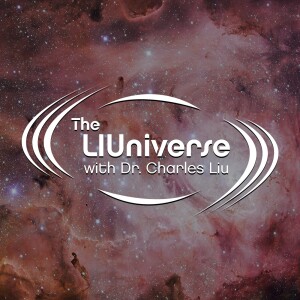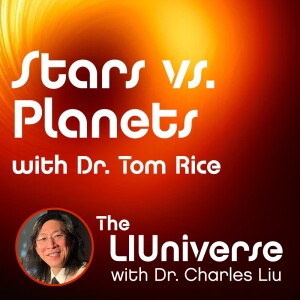
The LIUniverse with Dr. Charles Liu
Science:Astronomy

How did our solar system get here? How did the Earth form? How commonly does that happen elsewhere, and how often do the conditions necessary for life come about?
To find out, Dr. Charles Liu and co-host Allen Liu welcome Dr. Tom Rice, Astronomer-Educator and AAS staffer, who studies star and planet formations, how solar systems come together out of the “stuff that’s out there floating in our galaxy like gas and dust.”
As always, though, we start off with the day’s joyfully cool cosmic thing, the discovery of “baby” brown dwarf TWA 27B that we are watching grow thanks to the James Webb Space Telescope. Tom explains that a brown dwarf is not massive enough to ignite the hydrogen in their cores and turn into a star, but is 13 times more massive than gas giant planets like Jupiter. Allen asks Tom about temporal scales and “baby objects” – Tom defines objects as “young” that are still accreting mass, and tend to be in the range of 1-10 million years old. And as for calling brown dwarfs failed stars, well, you’ll just have to watch or listen for Tom’s opinion about that very controversial subject.
Then it’s time for a student question, from Alianna, who asks, “Can a star turn into a planet?” To answer, Tom uses a different distinction between stars, brown dwarfs, and planets: how they form. He explains the development from a region of gas and dust that gets dense and then collapses under its own weight, into a circumstellar disc accreting matter with an object at its center, growing either into a star, or, if it’s too low a mass to ignite, a brown dwarf. A planet forms in a different process, not in the center of the circumstellar disc (aka, the protoplanetary disc) but out of the “stuff” in the disc, at the same time the star is forming. So, Tom says, the answer to the question is “probably no.” Tom and Chuck then discusss a couple of hypothetical situations that could possibly reduce a star to the mass of the planet. They also compare the atmosphere composition of planets and stars. In the case of Jupiter, the composition is very similar to the sun, but the temperature is much cooler, so there are some molecules that form in its atmosphere that would remain in their atomic states in the Sun.
Then we enter the goldilocks zone to discuss what it takes to create a planet that can sustain life, like on Earth. Tom runs down the “must haves” for life, and then turns to the search for earthlike exoplanets using the Kepler and TESS space telescopes. You’ll learn about the transit method of exoplanet detection and what we can learn from it, including size and orbital frequency (which helps determine distance from the sun and therefore habitable temperatures).
Next we hear about Tom’s work on the staff of the American Astronomical Society. His focus: figuring out how channel the energy of society members to improve astronomy education at all levels. If you have a suggestion for Tom, you can find him on Twitter (X) @tomr_stargazer or email him at tom.rice@aas.org.
This being The LIUniverse, Chuck Tom and Allen end up the episode talking about video games, from Super Planet Crasher to Space Engine 2 and Universe Sandbox to the Zelda game, Tears of the Kingdom which has a ton of physics stuff in it– yes, you read that right!
By the way, if Tom looks familiar to you, that might be because he was in our video Chuck recorded at the AAS meeting in Pasadena last year where he showed us his fluency with American Sign Language. Tom is a CODA (Child of Deaf Adults) and ASL and his signing identity is an important part of his heritage. He lives in Washington, DC, near Gallaudet University, the nation’s only entirely signing university, where Tom works with the Astronomy Club. He’s also working with The National Technical Institute for the Deaf at Rochester Institute of Technology on activities relating to the upcoming total solar eclipse on April 8, 2024 that will pass directly overhead.
If you want to see Tom sign a few astronomic terms including the one for “the planet we live on...the most important place we can know,” watch our video at https://www.instagram.com/reel/Ce4kc96gOT5/.
We hope you enjoy this episode of The LIUniverse, and, if you do, please support us on Patreon.
Credits for Images Used in this Episode:
– TWA 27B (left) and its larger companion (right) – European Southern Observatory, CC BY 4.0
– Circumstellar Disc (artist’s concept) – ESO/L. Calçada, CC BY 4.0
– Illustration of the origin of a Type Ia supernova – NASA, Public Domain
– The Kepler and TESS space telescopes – NASA, Public Domain
– Transit detection of exoplanet WASP-96 b – NASA, ESA, CSA, STScI, and the Webb ERO Production Team, CC BY 4.0
– Gallaudet University’s Chapel Hall – Carol M. Highsmith, Public Domain
– The National Technical Institute for the Deaf, at RIT – Photog, CC BY 3.0
– Path of the April 8, 2024 Total Solar Eclipse – NASA's Scientific Visualization Studio - Michala Garrison, Ernie Wright, Ian Jones, Laurence Schuler, Public Domain.
More Episodes
 2023-11-18
2023-11-18
 5.5k
5.5k
 2023-10-28
2023-10-28
 4.7k
4.7k
 2023-09-16
2023-09-16
 4.3k
4.3k
 2023-09-02
2023-09-02
 3.7k
3.7k
 2023-08-19
2023-08-19
 5.2k
5.2k
 2023-08-05
2023-08-05
 4.7k
4.7k
 2023-07-22
2023-07-22
 3.7k
3.7k
 2023-07-08
2023-07-08
 3.3k
3.3k
 2023-06-24
2023-06-24
 5.2k
5.2k
 2023-06-10
2023-06-10
 3.5k
3.5k
 2023-05-27
2023-05-27
 4.4k
4.4k
 2023-05-13
2023-05-13
 4.4k
4.4k
 2023-04-29
2023-04-29
 3.4k
3.4k
 2023-04-01
2023-04-01
 3.4k
3.4k
 2023-03-18
2023-03-18
 3.0k
3.0k
 2023-03-04
2023-03-04
 4.1k
4.1k
Create your
podcast in
minutes
- Full-featured podcast site
- Unlimited storage and bandwidth
- Comprehensive podcast stats
- Distribute to Apple Podcasts, Spotify, and more
- Make money with your podcast
It is Free
- Privacy Policy
- Cookie Policy
- Terms of Use
- Consent Preferences
- Copyright © 2015-2024 Podbean.com





